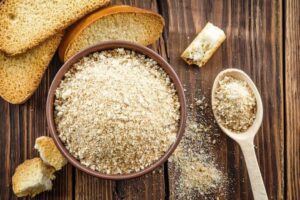Welcome to the first in my ingredient-focused posts in my Looking at Leftovers series (check out the kick off post to see what the rest will be about). I figured we’d start big with bread. Why big, you ask? Well, first – bread is one of the most thrown away foods in the US and the UK. It’s a big part of the leftovers landscape.

Second – big also refers to the size of the topic. Bread itself is an enormous subject – the types, the ways to make it, the ways to use it, store it, serve it.
Leftovers is also a subject worthy of considerable time and effort. So, I was unsurprised when what was supposed to be a single post decided to expand into a multi-part “series within a series.” We’ll tackle the basic issue here and discuss ideas for tackling it, then I’ll offer up some recipes and variations in the next part.
Going From Bread Bin to Waste Bin
Bread leftovers are not usually leftovers from last night’s dinner or from brunch-time entertaining (though I suppose some might be). It’s basic household waste in most cases, where for one reason or another, you’ve ended up not using the bread you have before it “goes off.”
- With sliced white or wholegrain this is largely down to the fact that sliced white loaves come mostly in one size regardless of how much or how little you want. I am seeing a few more “half loaves” these days and that helps two person households like ours avoid waste. But these half loaves are few and far between.
- Sometimes bread is an impulse or special treat purchase – you pick up an absolutely GORGEOUS artisanal loaf on a Saturday mooch about town and use only half of it by the end of the weekend. By the following weekend, it’s rock hard and you’re thinking it would make a lovely artisanal doorstop.
- Or maybe you’ve found yourself with leftover bread lately because you’ve been making your own bread more often and homemade bread goes stale MUCH more quickly than store bought. This should not in any way be an obstacle to making your own bread – it’s becoming hugely popular and people are often shocked at how easy it actually is. And with a few tips like those below, you will find lots of ways to use up that random third or half a loaf you find yourself tossing away.
Freezing Bread
Obviously you could freeze what you know you aren’t going to need. It is best to freeze the freshest bread you can – so if you know you’ve bought twice as much as you can reasonably use up in time, wrap half of it in two plastic freezer bags (ensuring it doesn’t get freezer burn) and seal thoroughly. It’s best used within a month. To defrost, take it out of the freezer and let thaw at room temperature for about 3 hours. But what if you don’t know how much you’re going to need over the next few days? You can still freeze the bread for straight re-use as long as you do it before it gets stale. But who keeps on top of their kitchen contents like that?
How To Use It Before You Lose It
Even I don’t, and I’m more than usually focused on leftovers these days. No, we need to keep the bread we bought in play as long as possible but also find a solution for the bread that’s left toward the end of its shelf life. So, what’s the answer?
- Buy only what you need? Even if you could (and I can’t think of anywhere that offers such a thing) no one is going to buy slices ‘a la carte’ as part of their regular (weekly or monthly) shop.
- Increase the variety of standard loaf sizes to allow for consumer preference? The size of loaves isn’t gonna change overnight. Those half loaves are very much an exception, not a rule.
- Eat more bread, more quickly? We’re not going to tell everyone EAT MORE BREAD RIGHT AWAY. Quite frankly, most of us probably eat too much bread already.
- Make smaller homemade loaves? Well, yes that might help if that is the bread you end up with as leftovers. A show of hands? Right. So not the answer for most of us, most of the time.
No, the answer is find new ways to use that bread that you know (from experience), is gonna end up either too stale or looking like a science experiment. Ways that you can use now OR later. Putting something in the freezer will make you feel a lot better than tossing it in the bin. Here’s a few suggestions you can adapt to almost any amount or type of bread you have at home.
Some use the bread up now (in possibly unexpected ways) and some extend the life of the bread by prepping it for use later.
- French toast and bread puddings: let your leftovers go stale, the better to soak up the custard-y goodness at the heart of french toast and bread pudding recipes. As for what kind of bread – you want something sturdy enough that it won’t go to pieces after soaking but soft and spongy enough to soak up the egg mixture properly. Challah is my bread of choice (boosting the eggy-ness of it all) but brioche works well also.

- Stuffing: use up your leftover bread AND any spare onions and bits of veg (adding chopped up carrots & celery is especially good) you’ve got lying around. Don’t need stuffing today? No worries – stuffing also freezes well if frozen after being cooked.
- Breadcrumbs and croutons: if you have a supply of breadcrumbs on hand, you’re half way to casserole toppings, meatballs, thicker soups, cheese patties or even fish cakes. In my opinion, breadcrumbs (seasoned or plain – or even better both) in the freezer are almost as useful as stock cubes or frozen herbs. Freezing breadcrumbs is even easier than making them. Just store in sealable plastic bag, making sure to label and date each batch (I suggest doing them in 1 cup at a time so you can thaw only what you need later on). Then pop them into the freezer for up to three months. To use: move frozen breadcrumbs into the fridge until thawed, then they’re ready to use.

- Sandwiches: I know what you’re about to say. You’re going to say “Duh, sandwiches. I could always have made another PB&J or another ham and Swiss. How is that helpful”? Well, if you want YET another ham and Swiss, then go ahead but I’m suggesting you broaden your sandwich horizons. Hot open faced sandwiches are not only a delicious, indulgent weekend lunch, they are a great way to use up leftovers from a big roast dinner. Yes, of course you end up using the leftover meat (sliced thin and stopped with a rich gravy) but you can also do a veggie version with any leftover roast veg, topped with slices of strong cheese. No roast dinner leftovers? No worries, grab those soon-to-be-binned hamburger or hotdog rolls and make some po-boys.
- Bruschetta: And what could be easier or more leftovers-friendly than bruschetta? Yes, it works best with crusty bread (If you’ve got some rustic type of loaf or part of a baguette lying around, these are perfect) but depending on what your topping is, almost any bread can be bruschetta-ized. Not pre-sliced white though. It’s far to thin, soft and squishy to hold up under any reasonable bruschetta topping. If that’s what you’re looking to use up. this is not your solution.

There are other ways to make use of bread – panzanella makes a great summer lunch, for example. And I’ll be pointing you in the direction of some of my favourites in part 2 of Looking at Leftovers: Bread. In the mean time, I’d love to hear how you use up the spare bread you’ve got going or any other leftover usefulness you might have up your sleeve. Stay tuned!
